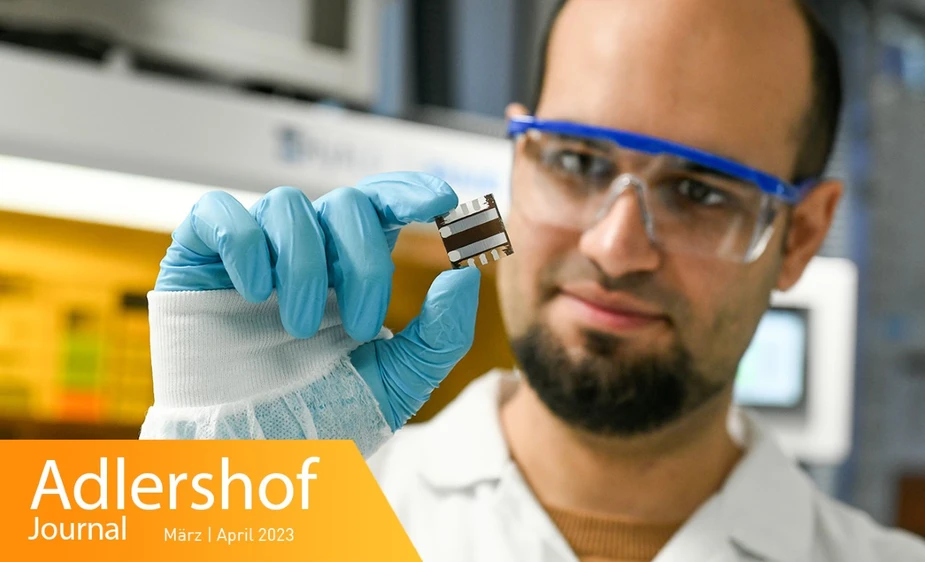Tackling the climate crisis with high-efficiency tandem solar cells
The research at Helmholtz-Zentrum has reached the pinnacle of its field
“No other sandwich will give you this amount of energy” – although this is putting it quite crudely, the sentence contains a highly scientific truth. After all, it was included in the presentation of Amran Al-Ashouri, a physicist, who won the Adlershof Dissertation Award in 2021. To compete for the annual award that is given out by WISTA Management GmbH and the Joint Initiative of Non-University Affiliated Research Institutes in Adlershof e.V. (IGAFA), young researchers must complete a dissertation in Adlershof graded with at least “very good” (magna cum laude). Like all nominees, Aman Al-Ashouri had only 15 minutes to present his scientific achievements in a way that is entertaining as well as educational.
He is a member of the Department Perovskite Tandem Solar Cells of Helmholtz-Zentrum Berlin (HZB), whose scientific insights are more relevant than ever.The physicist got his a-levels in Mühlheim an der Ruhr, a master’s degree at the University of Duisburg-Essen, and a PhD from Technische Universität Berlin (TU) before reaching the pinnacle of his field with the HZB’s solar cell.While conventional silicon solar cells reach a maximum efficiency of 26.7 percent, the HZB team’s tandem solar cells reach an efficiency of 29.15 percent.This success is partly due to the collaboration with Berlin-based and international research teams, particularly at the University of Kaunas, Lithuania. These achievements are spelt out in greater detail in an article published by Al-Ashouri with roughly 30 co-authors in December 2020 in Science.
The article deals with solar cells working in tandem much like a sandwich, which also requires two slices of bread to work. Tandem cells consist of two solar cells, one made of silicon, and one made of waver-thin perovskite, a material with excellent optoelectronic properties. Their chemical make-up as organic-inorganic metal halides and their crystal structure have been found to be conducive to producing highly effective solar cells. While the silicon cell is good at transforming the infrared part of sunlight, the perovskite solar cell is particularly effective for the light’s visible spectrum. They work in tandem and their efficiency is thus significantly higher than that of single solar cells. “We have managed to produce highly efficient solar cells with very little resource expenditure,” says Al-Ashouri.
However, none of the HZB researchers is resting on their laurels. The global race for tandem solar cells with the highest efficiency has not yet ended. A team from the Swiss Federal Institute of Technology Lausanne (EPFL) tweaked the peak to 31.3 percent in the summer of 2022. However, in late December 2022, HZB regained the top spot with an efficiency of 32.5 percent.
Amran Al-Ashouri continues to be involved in these scientific successes as a postdoc. Although his laboratories at HZB’s Silicon Photovoltaics Institute on Kekuléstrasse in Adlershof are currently being renovated, the research continues. The space is tightly packed with experiment kits. Long black plastic hoses hang from the long glass side, the ends of which are shaped like gloves. Clad in white protective clothing, an experimenter carefully sticks his hands into the black casings attached to the box, which are filled with gaseous nitrogen, and reaches for the small, thin square plates. “The substrates for the solar cells are coated in these gas-tight gloveboxes,” explains Al-Ashouri. In the neighbouring glovebox, perovskites are crystallising, substrates are provided with additional thin-film layers on a nanometre scale, while an artificial sun begins to shine. “During my dissertation, I spent a lot of time experimenting,” says Al-Ashouri. As a post-doc, he now supervises PhD students himself, builds optical measuring systems, and takes care of the analysis devices.
For the physicist, his academic and professional future is significantly shaped in terms of his contribution to tackling the global climate crisis.The prospect of being able to use his scientific contributions to improve energy efficiency, for example, motivated him to come to HZB in Berlin in the first place.Investigating tandem solar cells and increasing their efficiency – he chose the subject of his dissertation consciously because the results could contribute to tackling the climate crisis.“Now it’s about making good use of the knowledge gleaned from research,” says Aman Al-Ashouri.This is another reason why the winner of the Dissertation Award can imagine a professional future for himself in the industry.
Dr. Paul Janositz for Adlershof Journal
